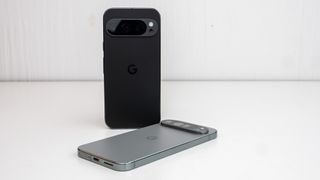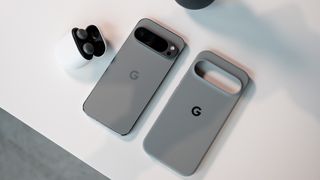Google Pixel 10: Rumors and everything we want to see
Pixels might finally get the processor upgrade we've been waiting for.

The middle of August was Pixel 9 season this year, but along with that launch came a few notable troubles. The Tensor G4 processor inside isn't any faster than previous Tensor processors in daily performance — especially when playing games on the Pixel 9 — the display still uses an abysmally low PWM rate, some of Google's AI features have been called ethically questionable, Google once again raised the price of its latest phones by $100, and the amount of storage space is pitiful for the price.
All of that left some of us feeling disappointed. So maybe you should wait to buy a Pixel 10, instead. We're taking a look at what we already know about the Pixel 10, including the new Tensor G5 processor, and putting everything together so you can make the best-informed decision with your hard-earned dollars this year.
The oft-leaked Google Pixel 9 was one of the industry's worst-kept secrets. That's not particularly surprising given Google's loose track record with leaks, and this year we saw prototypes and cases in the wild much earlier than usual. The number of Pixel 10 leaks is still fairly low but, given that the release isn't likely until Summer 2025, we have plenty of time to speculate based on several known factors.
Google Pixel 10: Price and release date

Google's current Pixel lineup is a bit convoluted. The Pixel 9 series debuted in four different sizes for the first time ever, and we're still expecting the Pixel 9a to make a debut at a reduced price sometime in Spring 2025. That leaves a big question mark on what Google will do for the Pixel 10.
Our thoughts are that Google needs to drop the "Pro" moniker and just stick with one main line of phones with a secondary line of more affordable Pixel A-series phones. For the Pixel 10 series, that would mean something like this:
- Pixel 10a
- Pixel 10
- Pixel 10 XL
- Pixel 10 Fold
The Pixel 9 introduced the first smaller Pro-level model, so we don't expect Google to go back on that idea. The smaller Pixel 9 is confusingly missing features that the "Pro" models have, and we think it would make more sense for an A-series model to be the one missing features, if Google is going to continue doing that.
As for the Pixel 10 release date, we expect that Google will likely launch the Pixel 10 near the end of Summer 2025. Google released the Pixel 9 just 10 months after it debuted the Pixel 8, making it the shortest time between releases we've seen yet. There's no reason to expect Google to do this again, but that might depend on sales of its latest flagships.
Be an expert in 5 minutes
Get the latest news from Android Central, your trusted companion in the world of Android
Google Pixel 10: Design and displays

The Pixel 9 introduced the most radical change to Pixel phone design since the Pixel 6, but that doesn't mean Google will stick to this radical new design language with the Pixel 10. One Pixel 9a leak suggests that the company is already considering a different direction for the future, and the company's head designer even said the Pixel 9's specific camera bar design might not stick around forever.
The Pixel 9's flatter design has received mixed reviews, something the Pixel 6-8 didn't really see. While Google ramped up build quality with this release, the shiny, flat side rails not only make it look an awful lot like an iPhone, but they also make the phone harder and less comfortable to hold than more ergonomic designs like the Pixel 8a.
Google has changed up the design language on Pixels a lot over the years. Pixels one through six all look completely different, and it wasn't until the Pixel 6 that the company seems to have decided on the camera visor as the thing that makes a Pixel primarily look like a Pixel. There's no guarantee of a radical change again next year but there's a lot of history behind the company doing that, so it wouldn't be a surprise.
Not everyone likes the new design, but Google has been known for radically altering the Pixel design language over the years.
The Pixel 9 debuted a brighter AMOLED display than ever, topping out at 3,000 nits. The company also upgraded the display with a new wet touch feature that makes it possible to use the screen even with wet hands, similar to how the OnePlus 12 works.
But while Google might have one of the brightest phone displays on the planet, the company has completely ignored industry trends to make displays more eye-friendly.
Namely, the company still uses the lowest PWM dimming frequency in the industry. At 240Hz, Google's displays flicker at half the rate of the Samsung Galaxy S24 series and the latest iPhones. Furthermore, phones like the OnePlus 12 only switch to PWM dimming at low brightness and, even when they do, use a substantially higher 2160Hz rate.
We know Google can push this rate much higher based on our own testing and the fact that most other smartphone manufacturers already do it.
Google Pixel 10: Cameras

There's little chance we'll see anything radical change with the cameras in the Pixel 10 series especially given that Google continues to push the envelope for AI-centric features. The company's own head of design said that the current camera bar design is mainly used to house larger camera sensors but that the company wants to shrink that going forward as AI replaces the need for more advanced physical hardware.
With tricks like Zoom Enhance, Google can continue to shrink the number and size of camera sensors on the back with little to no difference in the end. It's not likely we'll see this sort of change happen with the Pro series of phones — which we expect to continue to use a triple camera system on the back — but the more budget-minded Pixel phones could see a change in the camera bump size and shape to further differentiate Pro models.
We've also seen an uptick in the number of AI-powered software features directly related to the camera. The Pixel 9 introduced improved Night Sight Video, Night Sight Panoramas, enhanced Video Boost for better video quality, and new AI tricks like Add Me, Reimagine, and others. No doubt, Google is cooking up plenty of new ways to incorporate AI into its cameras to deliver the wow factor we expect from the company.
Google Pixel 10: Software

The Google Pixel 9 series surprisingly launched with Android 14, the same version of Android the Pixel 8 debuted with. This is mostly because Google released the Pixel 9 just 10 months after the Pixel 9, giving the Android team less than a full year to churn out a new version of Android.
A delayed Android version complicates Google's software promise, which is supposed to deliver seven years of Android and security updates for Pixel phones. Because of the release window, the Pixel 9 will see support end with the same Android version as the Pixel 8 — that's Android 21 — but will see ten additional security updates over that older phone.
The Pixel 10 will launch with at least Android 15 and could even see a launch alongside Android 16 depending on when Google wants to debut its next generation of phones.
Google Pixel 10: Specs and performance

Here's where we expect the Pixel 10 to deliver the biggest improvement yet. Google has long focused on the AI processing capabilities of its Tensor processors. The Tensor G4 in the Pixel 9 can process AI 2.25x faster than the leading competitor, the Snapdragon 8 Gen 3. But daily performance is a totally different story.
In my Pixel 9 Pro review, I noted that the gaming performance for the Pixel 9 Pro series was worse than the Pixel 8 Pro. The silver lining is that the Pixel 9 doesn't get as hot as the Pixel 8 does. Google prioritized efficiency with the Pixel 9 but the Tensor G4 is still based on the extremely inefficient Exynos line, which has trouble competing with the Snapdragon 8 Gen 1 in many situations, a 2021 chipset.
Thankfully, everything we know about the Tensor G5 so far tells us that it should be a monumentally better chipset in every way. Google has allegedly finished its design and sent it along for manufacturing at TSMC, ending the era of Samsung-produced designs.
The Tensor G5 is said to be Google's first fully in-house developed chip, manufactured by TSMC instead of Samsung.
TSMC tends to manufacture better chipsets than Samsung. For reference, Qualcomm used Samsung to produce the Snapdragon 8 Gen 1, a processor that was infamous for overheating and heavy throttling. They then switched to TSMC halfway through the year for the Snapdragon 8+ Gen 1, a processor that's largely the same design but, because of TSMC's superior tech, was able to significantly outpace the Snapdragon 8 Gen 1 in every benchmark. It also stays far cooler and is better on battery life.
That's all to say that we expect a similar thing to happen with the Tensor G5 compared to the Tensor G4. Not only should it be a far more efficient and cooler chipset because of TSMC's manufacturing process, but a brand-new chipset designed fully in-house by Google. It would mark the first time Google doesn't use a reference design from Samsung's Exynos line for the new chip, as well.
It could finally flip the narrative that Tensor is a slow, inefficient processor, helping Google further pitch the Pixel as a super premium device.
Google Pixel 10: Wishlist

While we've already covered a number of different changes we expect — and hope — to see, but it's sometimes easier to see them all in one list.
Better processor
We're already very sure that the Tensor G5 in the Pixel 10 is going to be a lot better than previous Tensor processors, but there's no guarantee until we have one in our hands. Tensor is already the king of AI processing among smartphone processors, but we want to see it thrive elsewhere, too.
Google seems to have put a band-aid on the heat problem with Tensor G4 by throttling the processor quickly when it's doing a lot, but we'd like to see the Tensor G5 push heavy workloads without getting steamy in the first place. The Snapdragon 8 Gen 3 is also susceptible to heavy throttling when running heavy workloads but because it's so much faster than the Tensor G4 in normal tasks, that throttling isn't felt like it is on Tensor.
Since the Tensor G5 is both in-house Google developed and manufactured by TSMC, there's hope that these issues will be solved in the Pixel 10.
More eye-friendly display
Google has stressed that the Pixel's displays have industry-leading brightness and color accuracy, but the company is achieving these metrics at the expense of your eye health. Meanwhile, companies like OnePlus are also using ultra-bright displays but managing brightness in a way that's far more friendly to human eyeballs.
As brightness continues to increase, it's of paramount importance that Google also starts increasing its PWM rate. All Pixels have used 240Hz PWM dimming to date — the lone exception is 360Hz on the Pixel 7a — while other companies are pushing up to 4320Hz on phones like the Honor 200.
There's no reason Google can't offer a bright, color-accurate display and a high PWM rate. At the very least, Google needs to consider the fact that some folks need a higher PWM rate in order to use its phones, again, especially as brightness continues to ramp up at exponential levels.
Fingerprint sensor changes
Google shifted to using in-display fingerprint sensors with the Pixel 6, and the company had problems with reliability on both that generation and the Pixel 7 after it. But last year, the Pixel 8 series optical fingerprint sensor worked incredibly well. Despite that, Google swapped out the optical sensor and replaced it with an ultrasonic sensor on the Pixel 9 series.
While ultrasonic fingerprint scanners work very well for some people, they're problematic for others. I happen to be one of those people who find ultrasonic sensors to be unreliable and commented on it in my Pixel 9 Pro review. Ultrasonic sensors are also very picky about which screen protectors you can use, meaning you might accidentally waste your money if you don't get the right one.
Instead of all this in-display nonsense, Google should switch to a fingerprint sensor in the power button. They already do it on the Pixel Fold line and it works perfectly. The power button — or "side key" as some companies call it now — is the ideal place for a fingerprint sensor as it's easy to reach and use no matter how you're holding the phone. It's also more accurate than any in-display option.
Design changes
The Pixel 9's design has caused a fair bit of controversy with its iPhone-like side rails, buttons, and other similar design cues. It also does away with the "friendly" curves Pixel phones had been moving toward for a far more sterile, industrial design. While some enjoy this new look — as Android Central's Managing Editor, Derrek Lee, noted in his Pixel 9 review — I'm not a fan.
At least on the Pro models, I find the Pixel 9 Pro and 9 Pro XL to be more difficult to hold without a case. Google previously said its designs are now focused toward folks who use cases, so this isn't a section that everyone will agree with or even care about, but I'd like to see Google go back to using more rounded side rails again. More specifically, I'd love to see matte rails like we had on the Pixel 6, which remains one of the most comfortable phones Google has ever made.

-
Kojack42 I just can't bring myself to spend £1000 on a smartphone with a Tensor chip, just no where near a Snapdragon if they want to keep the price down maybe go to the 8/2.Reply
Hense buying the Honor Magic 6pro -
Bkdodger1 I know a lot of people talk down of the tensor chip but coming from a user that has had the P8P and P9PXL now there is no performance drop down from the Snapdragon that I also test drive and use daily. I know everyone does differently and they like to run all kinds of tests but I'd like to go by My real world experience.Reply -
Kojack42 I'm sure general day to day use is fine with the Tensor chip but they are charging pretty much the same price a full flagships with 8gen 3.Reply
The same reason I stopped buying Samsung for a while because in the UK they used the cheaper exynos chip but still charged £1000+.
Cheers